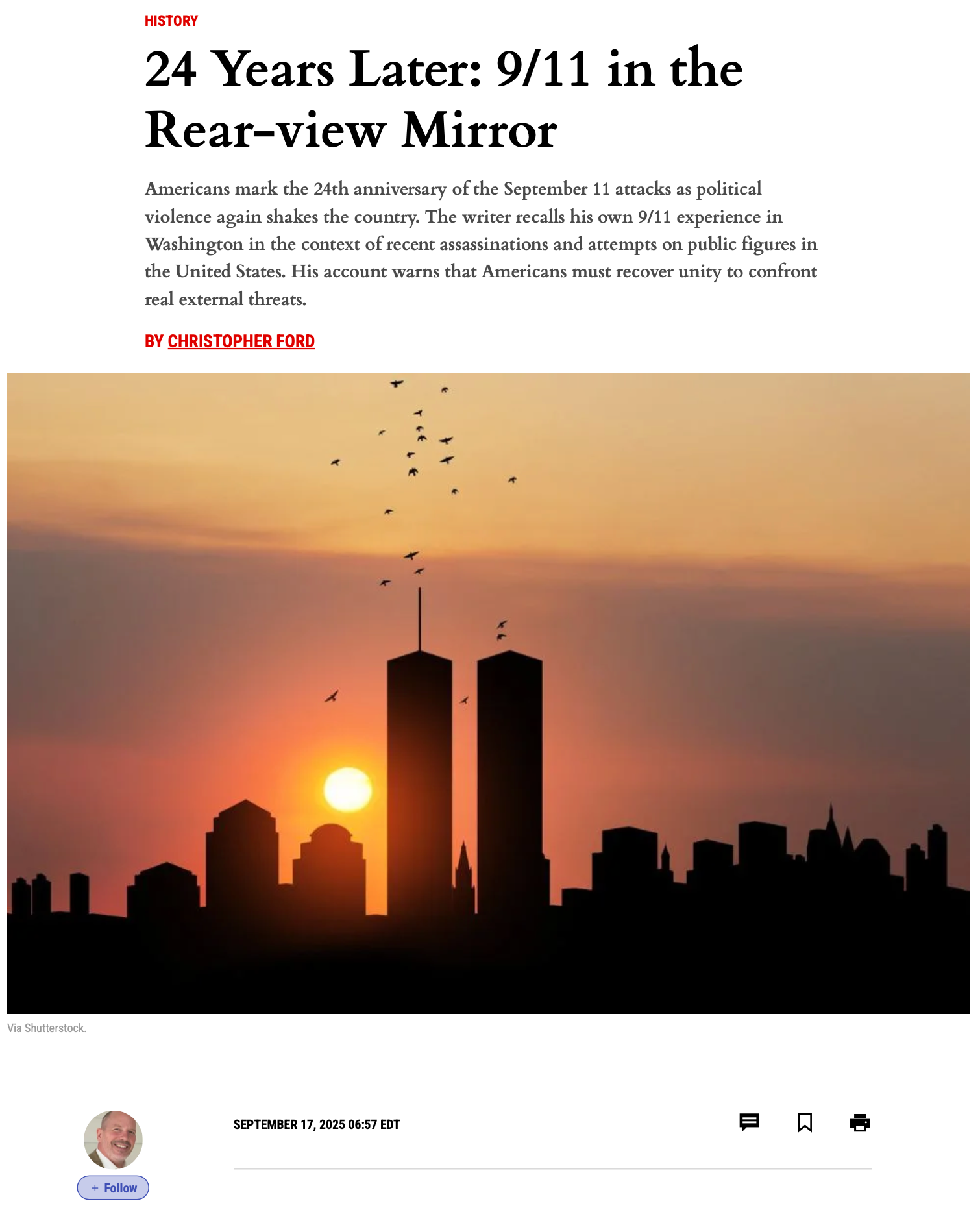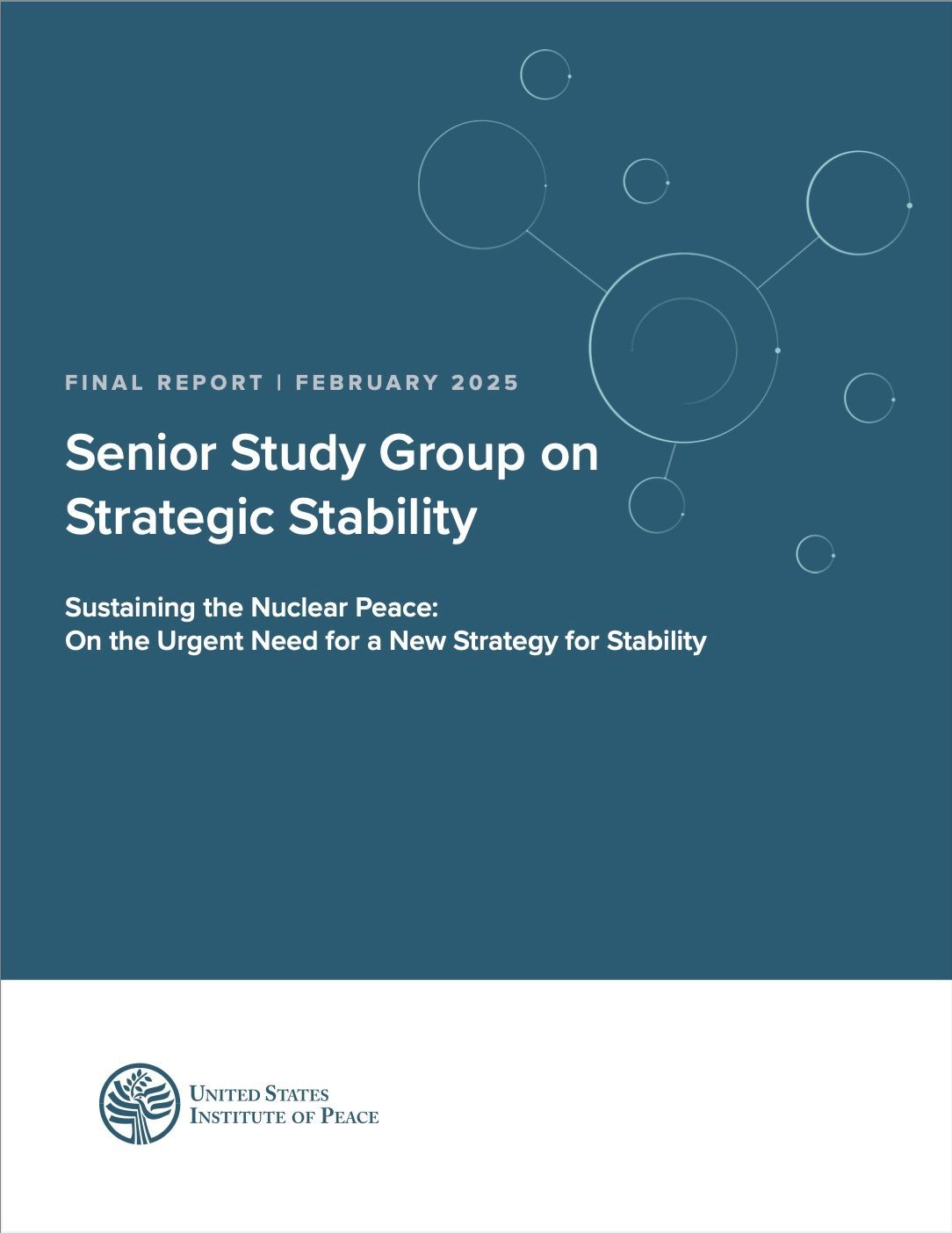Some Musings on Making Deterrence Policy
Below are the remarks Dr. Ford delivered in a lecture on October 16, 2024, to a group of students at Purdue University.
Good day, everyone, and thanks for your kind invitation to talk.
I’ve been asked to speak – from a practitioner perspective, drawing upon my experience as a Senior Director at the National Security Council staff and in performing the duties of the Under Secretary of State for Arms Control and International Security – about how deterrence policy is made, and I hope I can offer at least a little food for thought. (Remember, of course, that these are only my personal views, and that I speak here only for myself.)
But before exploring how U.S. deterrence policy is made, let’s start with the more basic question: “How does one find out what official U.S. policy actually is on deterrence in the first place?”
We live in a world, after all, in which there exist multiple important high-level U.S. national security guidance documents. We’ve got nuclear posture reviews, national defense strategies, and an array of unclassified and public national security strategy (NSS) documents. But since we don’t have a specific “nuclear deterrence review,” where does one go for an official statement of U.S. policy on deterrence?
In an important sense, the question of “where do you look for the official statement of deterrence policy” is conceptually antecedent to the question of how deterrence policy is set.
After all, as any good bureaucrat will likely tell you, at least part of understanding how policy is made is related to understanding who has the “power of the pen” in writing the first draft of the relevant official policy guidance document, whose approval is needed in the interagency clearance process, and whose final, high-level sign-off is ultimately needed for the document to be considered adopted. But to answer those questions, you need to know what document you’re actually talking about.
Where “Is” Deterrence Policy?
In recent years, the closest thing to a canonical “deterrence” document is usually the Nuclear Posture Review (NPR) issued by each presidential administration, though they tend to speak only to specifically nuclear weapons-related issues and U.S. officials – as we shall see – often speak much more broadly about deterrence elsewhere. And I’ll talk more in a few minutes about how such things get drawn up, at least based upon what happened in the Trump Administration with the 2018 NPR.
But there isn’t really a deterrence-specific policy guidance document in the sense of a clear articulation of how the U.S. Government thinks about deterrence as a concept – e.g., what it means, how exactly it works, what will (or won’t deter) specific adversaries, what its strengths and limitations are. NPRs – and indeed all national guidance documents – are very practical things, frequently relying upon assumptions in these respects, but seldom articulating them very directly. While such articulations hopefully reflect clear thinking about deterrence at the level of theory and doctrine, they seldom set such thinking out in clear form.
An unusual exception is Ronald Reagan’s National Security Strategy of January 1987. There, for instance, it is stated that
“Deterrence can best be achieved if our defense posture makes the assessment of war outcome by the Soviets, or any other adversary, so dangerous and uncertain as to remove any possible incentive for initiating conflict. Deterrence depends both on nuclear and conventional capabilities, and on evidence of a strong will to use military force, if necessary, to defend our vital interests.
“… Nuclear deterrence, like any form of deterrence, requires us to consider not what would deter us, but what would deter the Soviets, whose perceptions of the world and value system are substantially different from our own. Since we can never be entirely certain of Soviet perceptions, it is of the utmost importance that the effectiveness of our strategic capabilities – and our will to use them, if necessary – never be in doubt.
“…[W]e seek to deter an adversary with a very different strategic outlook from our own – an outlook which places great stress on nuclear warfighting capability. It is essential the Soviets understand that they cannot gain their objectives through nuclear warfare under any conceivable circumstances. To achieve this we must ensure that they clearly perceive that the United States has the capability to respond appropriately to any Soviet attempt to wage a nuclear war, and that we have the means to do this in ways which will defeat Soviet military objectives without necessarily triggering a massive nuclear exchange.” [pp.21-22]
For the most part, however, if you’re looking for an official statement of U.S. deterrent policy from a sort of theoretical and doctrinal perspective, you’re not likely to find such a thing. Our government produces policy guidance documents, not conceptual primers or theoretical exegeses. Moreover, such conceptual frameworks change much more slowly than the practical realities of the policy agenda, with the result that it is usually the case that administrations feel little need to spell out the conceptual underpinnings of the particular policy choices they are recommending.
To some extent, in fact, it may be that deterrence policy not really “made” by anybody in any comprehensive way at all, except in the aggregate. As you will doubtless have seen in your work, there are enough longstanding continuities over time in the U.S. approach that you might view each administration as not too much more than a steward and groundskeeper for deterrence.
Each presidency has the responsibility of maintaining the basic deterrent policy it has inherited from its predecessor-stewards. Administrations try to improve, modify, and shore up specific approaches as needed, but they generally improvise only within broad unwritten conceptual guidelines and understandings about how deterrence works that were established long ago, and which remain generally accepted as received wisdom and common sense in the present day.
The decades-long acquisition timetables and operational lifespans of our nuclear weapons and delivery systems, of course, also contribute to this dynamic. In a purely physical and programmatic sense, senior leaders lack the option of an entirely “Greenfields” approach of rethinking and redoing things from scratch, because it takes so long and costs so much to do anything significantly different or new. Here too, therefore, there’s a lot of path-dependency, and approaches change slowly.
There are, of course, always crucial questions and wrinkles that need to be addressed, and these are hardly minor details. To the contrary, they are absolutely critical, since whether deterrence works in the case of any given adversary at any given point in time depends upon the very specific circumstances with which you confront that adversary. (Deterrence is dynamic, not static, and if you’re not clearly active and engaged in the business of deterring that adversary, he might very well conclude that you’re asleep at the switch – which can mean deterrence failure.) Nevertheless, in the deepest sense, the basic insights, concepts, and assumptions of deterrence policy probably go back a long way and change comparatively little over time.
For this reason, and no doubt others, it is hardly surprising that nobody writes theses on deterrence theory in government guidance papers. Mostly, they just explain the latest groundskeeping and stewardship strategy within those broad inherited parameters, leaning heavily upon a great many assumptions that aren’t usually articulated.
How Do We Think About Deterrence?
The Biden Administration’s Nuclear Posture Review of October 2022 is the current document that talks most about deterrence, at least nuclear deterrence. But it’s worth noting that there appears to be a lot more about deterrence, as the Biden Administration sees things, than just nuclear weaponry – and indeed a lot more to deter than just warfare against us.
Whereas Reagan’s 1987 NSS talked almost exclusively about deterring Soviet military aggression, Joe Biden’s 2022 document has a long laundry-list of things that it says we must “deter” – up to and including “coercion in all its forms” [p.38 (emphasis added)]. This makes it harder to answer questions about what our deterrence policy is, who develops it, and who implements it.
If deterrence means keeping all bad actors from doing all bad things, after all, and if every part of the government needs to be “seamlessly integrated” to this end, is anything not part of U.S. deterrence policy? And if such policy pervades everything, who is not involved in making or implementing it? (Moreover, one might even ask, do we actually have a real deterrence policy at all? As the saying goes, if everything is special, then nothing is special.)
But for our purposes today, let’s focus upon the traditional core of deterrence policy: deterring direct military attack on the United States, its allies, and its partners – and especially the role of nuclear weaponry in ensuring such deterrence. How is deterrence policy made there?
Preparing the 2017 National Security Strategy
I cannot speak to how the Biden Administration’s National Security Strategy and Nuclear Posture Review were put together, of course, but I can offer at least some insight into how things worked in the Trump Administration.
I had the good fortune to be involved in the process of crafting the Trump Administration’s NSS when I served on the National Security Council (NSC) staff. The head of the team that produced that document was a friend and colleague of mine, Nadia Schadlow, who had been brought onto the NSC staff for that very purpose.
In bureaucratic terms, at least, the process of actually putting together each administration’s NSS is actually relatively straightforward. NSS documents are each president’s opportunity to express a distinctive “take” on the world and on national security policy, providing a kind of “commander’s intent” signal to the rest of the bureaucracy to guide its various components as they build strategies and implementation plans in their own respective spheres of responsibility. These strategies generally aren’t too long on programmatic details, but they do very self-consciously signal priorities and set tone at the highest levels.
Drafting-wise, the interagency clearance process for NSS documents tends not to be as elaborate as for some other policy documents, primarily because they are the president’s own “signature” national security documents, the president doesn’t formally have to check with or clear such things with anybody else.
In the case of the 2017 NSS, I actually don’t know how much out-of-the-White-House clearance there was when Nadia ran the process. But I do know that the proxy interagency clearance process, as it were, of coordination among the various NSC subject-matter and regional directorates was, to my eye, comprehensive and effective.
Nadia’s small team of drafters was commendably engaged with me and my own directorate during the process, soliciting input and suggestions and clearly listening carefully to what we offered in response – including when I recommended adjustments in substance, tone, or phrasing. If the relationship between the other directorates and her team was anything like how they dealt with us, I’d say the process was a model of coordination across NSC subject-matter areas and experts.
That’s pretty good for a document that, in bureaucratic terms, could perfectly “legitimately” be drafted in secret by a small cabal and then forced upon the rest of us by the National Security Advisor. So kudos to Nadia, her team – and our boss H.R. McMaster – for steering that 2017 process so well. I can’t speak to what edits, if any, occurred as the document was sent “upstairs,” as it were, for President Trump’s final approval, but I don’t recall seeing any significant or problematic changes occurring in that process. It all seemed to work really well.
Preparing the 2018 Nuclear Posture Review
But the NSC is pretty small, and even the entire Executive Office of the President not a lot larger. The mechanism by which high-level policy guidance documents are developed is much more complicated when it comes to texts such as the National Defense Strategy and the NPR, which are Department of Defense (DoD)-led processes and involve a muchlarger cast of characters.
Since all organizations are made up of humans, however, there often tends to be one person or two people who play unusually large roles in the drafting process even for those larger undertakings. This was the case, for instance, with Robert Soofer and Greg Weaver for the 2018 Nuclear Posture Review, Elbridge (“Bridge”) Colby for the 2018 National Defense Strategy, and John Rood for the 2019 Missile Defense Review. (Keith Payne is similarly remembered in connection with President George W. Bush’s 2002 NPR, as is Brad Roberts with President Obama’s NPR in 2010.) There are many, many people involved in producing such documents, but a few procedurally central players generally have critical roles.
I myself contributed only in pretty modest ways to the 2018 NPR, primarily through attending a number of working group meetings at the Pentagon on various issues being considered as its drafting progressed. Perhaps my most dramatic personal involvement, however, came near the end, when as a backbencher at an NSC “Principals Committee” (PC) meeting I managed to get into a pretty intense – though thankfully not heated – discussion with Secretary of Defense James Mattis over some of the fine details of U.S. nuclear weapons declaratory policy vis-à-vis the so-called “negative security assurance” offered in the NPR.
From my spot at the NSC, I had been advocating for a particular approach against DoD resistance for some weeks, and at this final meeting, Mattis and I basically debated the issue in front of everybody. Perhaps not surprisingly, the Secretary of Defense proved more influential among his colleagues at the PC than did I, and the group duly opted against my suggestion. Like the true gentleman he is, however, Mattis came up to me afterwards and graciously thanked me for my input.
If I’m going to offer you a useful peek into some of how deterrence policy is made, however, you deserve a more detailed account of the 2018 Nuclear Posture Review than just that anecdote about me arguing with a man who’s now a colleague of mine at the Hoover Institution. So thanks to some invaluable input from my former colleague Rob Soofer – himself, as I mentioned, one of two lead Pentagon officials shepherding that NPR through the process, along with Greg Weaver – I’ll offer you as complete an account of the process as I can.
In 2017, as people geared up to begin drafting the 2018 NPR, it was felt that there were two basic possible approaches that could be taken:
- to draft the document in a small group and seek thereafter to build support for the document; or
- to draft it through a large and comparatively inclusive process, presumably facing correspondingly easier approvals thereafter.
It was decided to take the second path. Although involving a couple of dozen different institutional stakeholders would certainly make the drafting process bureaucratically challenging, the stakeholder “buy-in” that could be created by such early inclusiveness would aid not just in getting final interagency approvals but also in the document’s subsequent actual implementation in practice.
And that was an important decision. Policymakers, and especially political appointees who come into government from the outside, often feel that they’ve “finished” when they have issued an important new guidance document. This, however, overlooks the challenges of actually implementing new approaches in practice and over time.
Many an ambitious administration has fallen down in actually implementing its policy priorities, and not because there’s some hostile “Deep State” always there advancing its own agenda against Republican and Democrat administrations alike. For the most part, it’s really just that implementing policy and being responsible for real-world outcomes in a complex system with a huge number of moving parts – and across a bewilderingly broad range of equities that exist to a great degree in tension with each other – is inherently just bloody hard. Appointees with bureaucratic experience in government understand this better than pure political loyalists without such background, and to their credit, U.S. leaders during the 2018 NPR process were deeply experienced, and took implementation equities very much into account from the outset.
So in the circumstances of 2017, at least, I think it made sense to “go big” early in terms of bureaucratic participation. That initial breadth of stakeholder inclusiveness certainly made the drafting process quite elaborate, of course. The process involved institutional participants from various portions of the Pentagon, the Joint Chiefs of Staff, and other parts of the military establishment, but also stakeholders such as the NSC, the State Department, and the Office of Science and Technology Policy (OSTP) at the White House.
There had been some very high-level guidance from the White House itself, which encouraged the drafters to focus on great power competition issues – as indeed presaged by the 2017 NSS itself, which was then in the process of being assembled. Getting this kind of broad advance input from the White House on general themes is common with big guidance document efforts such as the Nuclear Posture Review, but it was sensibly left to those with more direct knowledge and expertise to make recommendations on the NPR details.
Accordingly, a great many expert offices were soon at work, through an organizational process that proceeded from a series of threat analyses to an assessment of strategic needs, and then to an evaluation of the forces needed in order to implement those requirements. At every major juncture point, tentative results would be taken for “socialization” and quality control to a Senior Steering Group (SSG) chaired at the Pentagon at the Assistant Secretary level – which was now I myself first got involved, for I was NSC Senior Director for WMD and Counterproliferation at the time.
Each time the SSG approved a key element of the NPR, it was taken first to the Under Secretary of Defense for Policy (USD/P) and the Joint Chiefs, and thereafter circulated to the White House and to NSC Deputies’ Committee (DC) and PC meetings for approval. (Interestingly, Secretary Mattis himself also created a sort of bipartisan “greybeard” oversight panel of former senior leaders, then out of government, from which he elicited feedback in some particulars.) By the time Mattis took the completed draft to President Trump, it had been seen by and socialized with a great many stakeholders multiple times – in various pieces corresponding, as I noted, to “threat,” “strategy,” and “forces.”
This coordination process seemed to go quite well, and getting the whole thing approved in the interagency and then by the White House seemed, as far as I could tell from my spot at the NSC, remarkably straightforward. Given that the 2018 NPR called for the addition of two new nuclear systems to the U.S. arsenal in order to make up for gaps vis-à-vis Russia and China in “theater”-type forces – and that it expanded President Obama’s caveat in U.S. declaratory policy about the applicability of nuclear deterrence vis-à-vis biological warfare (BW) alone to cover any “significant non-nuclear strategic attack” – this ease of approval might seem surprising.
My own “nuclear vision review” of disarmament policy at the NSC had also made clear, however, the wind had by then quite left the sails of President Obama’s ambitious – if perhaps naïve – policy of seeking to “lead” the world toward nuclear weapons abolition. By the time we were working on the NPR in 2017, we knew Russia had been in violation of the Intermediate-range Nuclear Forces (INF) Treaty for years, and that the Kremlin had never complied with its promises from the early 1990s to reduce its shorter-range nuclear forces. We also knew that Russia was building a whole new range of “exotic” and disturbing strategic weaponry – though Vladimir Putin didn’t announce that publicly until March of 2018 , the same month his hit squad tried to kill a British citizen on British soil with chemical weaponry – and that China’s military and nuclear modernization continued apace.
(Interestingly, at that time we didn’t yet know that China would be hugely expanding its intercontinental ballistic missile forces toward what looks now to be at least parity with the United States at “about 1500 warheads” by 2035. We would have been more forward-leaning still had that skyrocketing threat been understood in 2017, and it’s very problematic that the Biden Administration – which by 2022 did know about this massive Chinese build-up – nonetheless chose to lean backward rather than forward in its own NPR.)
But even in 2017, we it was also clear that wars of territorial aggression had returned to Europe with Vladimir Putin’s attack on Georgia in 2008 and invasion of the Ukrainian territories of Crimea and the Donbas in 2014. It was also clear that Chinese threats against Taiwan and in the South China Sea were rapidly increasing.
The nuclear disarmament-friendly themes of Obama’s famous “Prague Speech” of April 2009 had thus gotten us, in the most charitable interpretation, precisely nothing in terms of improvements in adversary behavior. If anything, our adversaries saw Obama’s disarmament push as creating a greater incentive to increase their nuclear capabilities, concluding that America wanted them to eliminate nuclear arms so that we could rely more successfully on conventional power against them. (It also may have signaled to them that Americans were particularly afraid of nuclear weapons and uneasy about relying on nuclear deterrence, thereby giving Russia, China, North Korea, and even Iran more reason to confront us with nuclear saber-rattling as an instrument of coercive bargaining. We are thus perhaps reaping what Obama sowed today.)
With all of us knowing this backstory as we worked on the 2018 NPR – and understanding that the forthcoming 2017 National Security Strategy would quite correctly focus upon great power competition above all other security threats – the U.S. interagency process for the 2018 NPR was impressively non-adversarial and straightforward.
If anything, the toughest decision-making in the Pentagon on these topics – as I understand things, at least – was not on strategy or policy requirements but simply budgetary. Could we afford to pay for a new submarine-launched missile to replace the older variant that President Obama had unwisely scrapped in 2010? And what would the impact of our choices be on resourcing for other programs such as ongoing life-extension programs (LEPs) for U.S. weapons? These budgetary questions were ultimately answered, of course, but on what the necessary strategic choices actually should be in terms of deterrence policy and nuclear posture, all the important players thankfully seemed to agree throughout the process.
Conclusion
So that’s about as good an account of the 2018 NPR process as I can give, and – as noted – I’m grateful to Rob Soofer for helping me with various details I myself would otherwise have missed.
I hope I’ve made clear that in the broadest sense, I don’t really think deterrence policy is actually usually “set” in a crisp and straightforward way. Instead, the conceptual assumptions and analytical foundations upon which it rests remain in some ways more inherited and assumed than directly explored and clearly expressed.
Nevertheless, when it comes to the most relevant institutional articulations of what we are doing to ensure deterrence, the government is capable of organizing itself fairly effectively to build and articulate policy responses to an evolving threat environment. I hope I’ve offered you a useful case study example of how this worked for us in 2017.
— Christopher Ford







